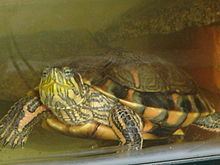Order Testudines Phylum Chordata Subclass Anapsid | Subphylum Vertebrata Subfamily Deirochelyinae Higher classification Slider turtles Rank Species | |
 | ||
Similar Turtle, Slider turtles, Reptile, Chelidae, Phrynops | ||
D'Orbigny's slider or the black-bellied slider (Trachemys dorbigni ), commonly known in Brazil as tigre d'água (which means water tiger in Portuguese), is a species of water turtle in the family Emydidae. The species is found in southern Brazil, northeastern Argentina, and Uruguay. One subspecies (in addition to the nominate subspecies) is distinguished, Trachemys dorbigni brasiliensis.
Contents
Etymology
The specific name, dorbigni, is in honor of French naturalist Alcide d'Orbigny.
Description
The form of the plastron determines its gender. After a few years of life, show differences between male and female. Males have a penis that is inserted into the tail. It becomes apparent only during the mating season when it is inserted into the female's cloaca. D'Orbigny's slider has a life span between 30 to 100 years in captivity.
They are usually found in water bodies such as lakes, marshes, streams and rivers. They have a preference for waters with low or moderate currents, soft bottoms and abundant aquatic vegetation.
Babies are born weighing 11 grams (0.39 oz) with a 3.5 centimetres (1.4 in) carapace. The average growth rate is about 3 centimetres (1.2 in) per year on wild, but in captivity it can grow faster being able to grow over 9 centimetres (3.5 in) in a year. The females can grow up to 30 centimetres (12 in) carapace and weight over 2.7 kilograms (6.0 lb), while the male can only grow 25 centimetres (9.8 in) carapace. When the males reach sexual maturity (after 2 years), they acquire a dark color while the females keep the same green after maturity (at 5 years).
Sexual dimorphism
The sex identification is only possible when adult, at 5 or 6 years. The female is bigger and may reach 30 centimetres (12 in) in length and has the bottom of the shell (plastron) slightly convex so as to provide more space for eggs. The male reaches 20 centimetres (7.9 in)to 25 centimetres (9.8 in)and has a longer and bulky tail, furthermore, the male bottom of the shell is straight or slightly concave to fit better upon females.
The male's cloaca is located 2/3 the distance between the tail beginning and the shell, while the female is very close to the shell.
Reproduction
Females produce an average of 10 eggs per buried nest; usually they bury two nests per season. Incubation ranges from 2 to 4 months. The eggs are laid under approximately 10 centimetres (3.9 in) of sand. The eggs are white-colored. Each egg on average measures 39.3 millimetres (1.55 in) in length and 25.8 millimetres (1.02 in) in width, weighing on average 14.9 grams (0.53 oz).
Only 31% of the female population lays egg each year.
The sex of baby turtles is determined by the temperature of the sand during incubation, lower temperatures increase the number of females.
Diseases
The turtles can catch diseases such as pneumonia, dystocia, bone decalcification, vitamin deficiency, gastroenteritis, and prolapses.
Pet owners must avoid using small objects as decoration in their tank, because they tend to eat everything they can.
Despite being very resistant may have rachitis, a disease that leaves the shell soft due to protein deficiency. It can be corrected by adding protein to meals, especially through fish.
Placing turtles in rough places can also cause injury under the hull, which provide the entry of fungi and bacteria.
To avoid diseases it is recommended that you utilize a tank with heating system, provide the turtles with daily sun light or special UV light so that they can metabolise the vitamin D.
Diet
These omnivorous turtles can eat almost anything in nature shrimps, vegetables, fruit, carrion, small fishes, snails, worms, etc.
During the first two years of life these turtles are mainly carnivorous, eating small animals and carrion, but then they switch to being mainly vegetarian eating more vegetables and algae then meat.
Diet in captivity
For pet keepers it is recommended that you feed them more than once every day in the first two-years, then shift to feeding once every two days. Avoid feeding them with lettuce because it gives them diarrhea
Brazil
This species can be owned only with specific documentation. The purchase invoice must contain the popular and scientific name, and designate the number of animals. Also required is a certificate of origin, invoice number and the number of commercial breeding of wildlife as recorded in the Brazilian IBAMA.
It is forbidden to release the animals in nature and is subject to the penalties provided in the law No. 6.938/81 and No. 9.605/98.
If the owner can no longer keep it, the store that made the sale is obliged to take the animal back, the animal will be shipped back to the only farm allowed to breed them in Brazil.
Uruguay
In Uruguay turtles can only be owned with specific documentation and as they are a protected species commercialization is forbidden.
